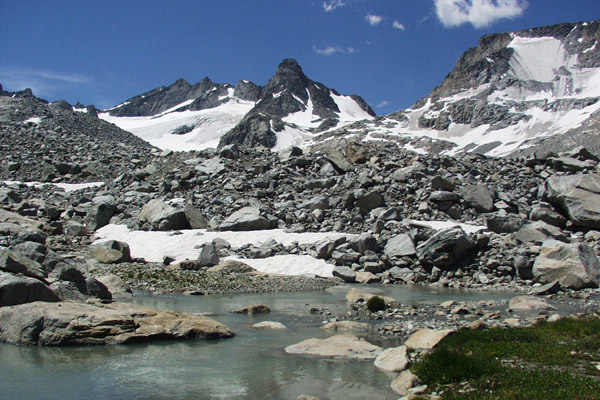Biogeochemical Implications of Glacial ErosionRobert Stallard: Telephone: +1-303-541-3022; FAX: +1-303-447-2505 |  |
Biogeochemical Implications of Glacial Erosion
Robert Stallard: Telephone: +1-303-541-3022; FAX: +1-303-447-2505
e-mail: stallard@colorado.edu
(4) Biogeochemical Implications of Glacial Erosion: Continental and alpine glaciers generate vast quantities of sediment, expose fresh bedrock, and generate expansive deposits of fresh deposits. The high ratio of fresh rock to water in the subglacial environment results in rapid chemical weathering per amount of runoff. This weathering is dominated by reactions unlike those of non-glacial settings. The subsequent weathering of glacial deposits and exposed bedrock along with ensuing soil development all appear to affect biogeochemical cycles in ways that may be calibrated from the ice-core and marine geochemical record. Research has focused on the South Cascade Glacier and a geologically matched watershed in Puerto Rico, the Icacos River Basin. This approach is extended to the continental scale using data from the Mackenzie River Basin and the general Laurentide Region to compare with data from the Mississippi, Amazon, and Orinoco river basins. Research now focuses on the glaciers based on Precambrian bedrock analogous to the rocks under the much of the Laurentide Ice Sheet. Fieldwork has been undertaken on the glaciers in near the Fremont Glacier in the Wind River Mountains.
Theory: The question is whether subglacial weathering was a source or sink for CO2 during the late Pleistocene. From Stallard (2000):
"Ice Ages end much more quickly than they develop, and the marine chemical record indicates that this was an unusual time. Late in the last glaciation and during glacial retreat, the oceans had Sr-87/Sr-86 ratios and Ge/Si ratios greater than those of today. The source of excess Sr-87 is radioactive decay of Rb-87 in potassium-bearing minerals; thus, an especially strong source of Sr-87 is the weathering of potassium-bearing minerals in old continental crust such as the Canadian Shield. In today's world, water that has high Ge/Si ratios are either draining terrains undergoing transport-limited erosion or rivers contaminated by ash from coal burning, where the Ge is associated with organic matter and sulfides. If we use today's world as a reference frame, the late-glacial data indicate a strong contribution of Sr-87 and Ge from a shield terrain undergoing intense tropical-style weathering. This contradicts all that we know about global climate of the time."
"Investigators studying warm-based mountain glaciers and glaciated areas have noted that even in granitic areas, waters are particularly high in calcium, potassium, and sulfate ions relative to other major soluble cations and. One source of calcium appears to be intergranular calcite, one of the last minerals to crystallize out of the cooling granite melt. Volumetrically, this calcite is a minor constituent. Calcite is also far more susceptible than other minerals in granite. A primary reason for the calcium abundance may be that the calcite is making a disproportionate contribution to the steam waters because of the recent exposure of fresh granite by glacial activity. Similarly, the excess sulfate may be from the weathering of disseminated trace sulfides. The potassium appears to come from the physical breakdown of micas in general and the oxidative weathering of vermiculite. Calcium bearing minerals release strontium with a low Sr-87/Sr-86 ratio, while the ratio derived from the micas is exceedingly high, especially in old rocks. The weathering sources of calcium and potassium during soil development persist well after glaciers have departed, but are relatively weak compared to sub-glacial sources. In the case of the Laurentide region, soil development took several thousand years and still continues. Micas and sulfides are potential sources of excess Ge/Si. Thus, the peculiarities of late Ice Age seawater may be cause by the different styles of chemical weathering associated with glaciers. This points to the need to examine biogeochemical processes in detail before drawing analogies between different processes in various terrestrial environments (erosion regime) and the data that need to be explained (marine chemistry)."
Recent Research Efforts (to find out more, click on effort):
- Robert Stallard Home Page.
- Global-scale process research involving biogeochemistry and geomorphology with a focus on terrestrial sedimentation and the carbon cycle.
- Luquillo USGS Water, Energy, and Biogeochemical Budget (WEBB) Project in eastern Puerto Rico and parallel work in Panama.
- Biogeochemical implications of event-type processes at the hillslope to small-watershed scale, focusing on fire-flood sequences and landslides.
- The life cycle of the giant Amazon water lily.
- Intercomparison of soils, nutrients, and plants in forest-dynamics research plots of the global tropics.
- The Neotropical amphibian die-off (RANA)
.
Return to: http://spot.Colorado.EDU/~stallard/
This Home Page
University of Colorado.
US Geological Survey